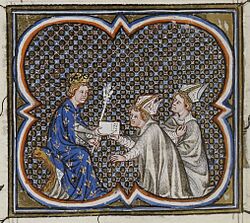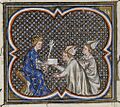Henry of Marcy facts for kids
Quick facts for kids Cardinal Henri de Marcy |
|
|---|---|
| Cardinal Bishop | |
| Diocese | Albano (1189–1197) |
| Elected | 11 March 1179 |
| Other posts | Abbot of Clairvaux (1177–1179) |
| Orders | |
| Consecration | 6 May 1179 by Pope Alexander III |
| Created Cardinal | December 1182 |
| Rank | Cardinal Bishop |
| Personal details | |
| Born | c. 1136 Chateau de Marcy, Burgundy |
| Died | 1 January 1189 (aged 52–53) Arras, Flanders |
| Buried | Arras |
| Nationality | French (Burgundian) |
| Residence | Hautecombe (Savoy), Clairvaux, Rome, Verona |
| Occupation | heretic hunter, diplomat, administrator, courtier |
| Profession | Cistercian monk, bishop |
Henry of Marcy, also known as Henry de Marsiac, was an important church leader who lived from about 1136 to 1189. He was a Cistercian abbot, first at Hautecombe in Savoy (from 1160 to 1177), and then at Clairvaux (from 1177 to 1179). In 1179, Pope Alexander III made him a Cardinal Bishop of Albano at the Third Lateran Council.
Henry played a big role in dealing with different religious beliefs, like Catharism and Waldensianism, in the late 1100s. He was also a key figure at the Third Lateran Council. He believed that church and government leaders should work together to solve religious disagreements.
Contents
Early Life and Becoming an Abbot
Henry was born around 1136 in a place called Castro Marsiaco, or Château de Marcy, in Burgundy, France. His family was noble, but not royal.
In 1155 or 1156, he joined the Cistercian order and became a monk at Clairvaux. Four years later, he was sent to lead a new monastery, Hautecombe, in Savoy, as its first abbot.
In 1177, Henry was chosen to be the seventh Abbot of Clairvaux. Around that time, he convinced Henry I, Count of Champagne, an important supporter of the abbey, to join a crusade. This made Pope Alexander III very happy, as he and Count Henry had not always agreed.
Dealing with Different Beliefs in Toulouse
In September 1177, Count Raymond V of Toulouse asked the Cistercian leaders for help. He was worried about the spread of Catharism in his lands. He said that he had already tried to solve the problem himself, but needed more help from the church.
King Henry II of England and King Louis VII of France were also concerned about the spread of Catharism in areas like Aquitaine. They decided to send a group of church leaders to preach and explain the true faith. Henry of Clairvaux was part of this important group.
The group also included Cardinal Peter of S. Crisogono, the archbishop of Bourges, and others. They were joined by noblemen like Raymond V of Toulouse. Their mission was to help the Bishop of Albi, who was being held by Vicount Roger of Béziers. Henry of Marcy's specific task was to get Vicount Roger to release the bishop and help resolve religious differences in the area.
When Vicount Roger refused to cooperate, the church leaders took action against him. However, the mission did not fully succeed in freeing the bishop or resolving all the disagreements in Béziers and Castres.
After this mission, Henry returned to Clairvaux. He oversaw the moving of Bernard of Clairvaux's remains to a new monument built under Henry's direction.
In 1178, Henry was chosen to be the bishop of Toulouse. However, he asked Pope Alexander to release him from this duty, as he wanted to meet the Pope at an upcoming general council.
Through Henry's influence, King Henry II of England gave the Clairvaux Abbey a new lead roof for its church.
Becoming a Cardinal and Papal Legate
Abbot Henry attended the Third Lateran Council called by Pope Alexander. The first meeting was on March 5, 1179. On March 11, Henry was appointed Bishop of Albano. He was made a bishop by Pope Alexander III himself on May 6, 1179.
From 1180 to late 1182, Henry served as a special representative of the Pope, called a papal legate, in France. His main role was to address the religious disagreements with the Albigensian people.
As a legate, Cardinal Henry led several church meetings (synods). For example, in 1180, he led a synod in Limoges to settle a long-standing conflict between two churches. He also held another synod in Nôtre Dame de Puy in September 1181.
In 1181, Henry, along with other bishops, removed Pons d'Arsac from his position as bishop of Narbonne. The reasons are not fully known. This decision was later confirmed by Pope Lucius III in 1183.
Henry continued to hold synods in different places, like Bazas in November 1181 and Limoges in February 1182. In May 1182, he was in Paris and helped consecrate the main altar of the newly finished choir of Notre-Dame de Paris.
By November 1182, he was back in Italy, working with Pope Lucius III.
Working to Resolve Religious Differences
In 1177, Count Raymond V of Toulouse had asked for help with the spread of Catharism in his lands. In response, the Cistercian leaders decided to send Henry to Languedoc as a papal legate. He led a group that included other important church figures.
Henry met Peter Waldo in 1180 and helped him confirm his Catholic faith.
Henry returned to Languedoc in 1181 and led a group to the town of Lavaur. The town's leader, Roger's wife Adelaide, surrendered the town to him peacefully. Henry then removed Pons d'Arsac from his bishop position because he was seen as "useless and reprehensible."
Preaching for the Crusades
Towards the end of his life, Cardinal Henry was considered as a possible next Pope in October 1187. However, he chose to step aside, saying he wanted to focus on preaching for a new crusade. Another cardinal, Alberto di Morra, was then elected Pope.
Henry continued to work for the new Pope, Gregory VIII. He was appointed a papal legate to France to try and make peace between King Philip II of France and King Henry II of England. He traveled to Flanders to meet with Count Philip.
He actively preached for the Third Crusade. In March 1188, he was in Liège, encouraging people to join.
Henry played a big part in bringing peace between the leaders of the Crusade. He helped King Henry II of England and King Philip II of France reconcile. He also helped resolve a disagreement between Emperor Frederick I and Philip I, Archbishop of Cologne. At a meeting in Mainz on March 27, 1188, he convinced Emperor Frederick to join the Crusade.
Henry died in Flanders in July 1189 and was buried in Arras. However, some records say he died on January 1. He is considered a blessed person in the church.
Some of his writings, including his letters and a work called De peregrinante civitate Dei, are still available today.
Images for kids



